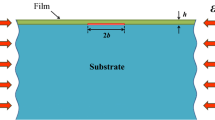Abstract
It is shown that unless the substrate is at least as stiff as the film, the energy stored in the substrate contributes significantly to the energy release rate of film delamination under compression either with or without cracking. For very compliant substrates, such as polyethylene terephthalate (PET) with a indium tin oxide (ITO) film, the energy release rate allowing for the deformation of the substrate can be more than an order of magnitude greater than the value obtained neglecting the substrate's deformation. The argument that buckling delaminations tunnel at the tip rather than spread sideways because of increase in mode-mixity may need modification; it is still true for stiff substrates, but for compliant substrates the average energy release rate decreases with delamination width and the limitation in buckled width may be due to this stability as much as the increase in mode-mixity.
Similar content being viewed by others
References
Beuth, J.L. (1992). Cracking of thin bonded films in residual tension. International Journal of Solids and Structures 29, 1657–1675.
Chai, H., Babcock, C.D., and Knauss, W.G. (1981). One-dimensional modelling of compressive failure in delaminated laminates. International Journal of Solids and Structures 17, 1069–1083.
Dundurs, J. (1969). Edge-bonded dissimilar orthogonal wedges. Journal of Applied Mechanics 36, 650–652.
Giola, G. and Ortiz, M. (1997). Delamination of compressed thin films.Advances in Applied Mechanics (Edited by J.W. Hutchinson and T. Wu) 33, 531–559.
Gough, G.S., Elam, C.F. and de Bruyne, N.A. (1940). The stabilization of a thin sheet by a continuous supporting medium. Journal of the Royal Aeronautical Society 44,12–43.
Hutchinson, J.W. (1996). Mechanics of Thin Films and Multilayers. Technical University of Denmark, Lyngby, Denmark, pp 45.
Hutchinson, J.W. and Suo, Z. (1991). Mixed mode cracking in layered materials, in Advances in Applied Mechanics (Edited by J.W. Hutchinson and T. Wu) 29, 63–191.
Jensen, H.M. (1993) Energy release rates and stability of straight-sided, thin-film delaminations. ActaMetallurgica et Materialia 41, 601–607.
Stringfellow, R.G. and Freund, L.B. (1993). The effect of interfacial friction on the buckled-driven spontaneous delamination of a compressed thin film. International Journal of Solids and Structures 30, 1379–1395.
Suo, Z. and Hutchinson, J.W. (1989). Sandwich test specimens for measuring interface crack kouhness. Materials Science and Engineering A 107, 135–143.
Suo, Z. and Hutchinson, J.W. (1990). Interface crack between two elastic layers. International Journal of Fracture 43, 1–18.
Thouless, M.D. (1993). Combined buckling and cracking of films. Journal of the American Ceramic Society 76, 2936–2938.
Thouless, M.D., Hutchinson, J.W. and Liniger, E.G. (1992). Plane-strain, buckling-driven delamination of thin films: model experiments and mode-II fracture. Acta Metallurgica et Materialia 40, 2639–2649.
Thouless, M.D., Jensen, H.M. and Liniger, E.G. (1994). Delamination from edge flaws. Proceedings of the Royal Society of London A 447, 271–279.
Author information
Authors and Affiliations
Rights and permissions
About this article
Cite this article
Cotterell, B., Chen, Z. Buckling and cracking of thin films on compliant substrates under compression. International Journal of Fracture 104, 169–179 (2000). https://doi.org/10.1023/A:1007628800620
Issue Date:
DOI: https://doi.org/10.1023/A:1007628800620



